People involved in cricket from 1597 to 1787
This article lists people who are known to have been involved in the historical development of cricket from its earliest known reference on Monday, 17 January 1597[a] to the opening of the original Lord's ground and the formation of Marylebone Cricket Club (MCC) in 1787. The tables are chronological, and each person's name is given when it was first recorded in surviving sources. The first is John Derrick who, in January 1597, made the legal deposition which includes the earliest mention of cricket on record. The last name, and the only one in 1787, is Thomas Lord whose new ground was opened at the beginning of that season;[b] MCC was founded soon afterwards.
In the 16th and 17th centuries, the names are those of people who may or may not have been regular players. Many are referenced only in court cases, or are people who witnessed the sport. The town or village given is where their involvement occurred. In the 18th century, more information is available in the sources so it is easier to identify the active players and the clubs or teams (i.e., parish or county) with which they are most usually associated. Although some people like the Dukes of Richmond are remembered primarily as patrons, they were invariably players too and generally captained their own teams. Cricket underwent radical changes during the 18th century. Patronage and popular support enabled it to outgrow its roots as a village pastime and develop into a major sport in southeast England which had begun its spread through the rest of the country by 1787.
There were three watersheds in cricket history during the 18th century, one evolutionary and two revolutionary. First, in 1744, the Laws of Cricket were formally codified. They were revised in 1774 and then, although it is outside the scope of this article, became the copyright of MCC in 1788 when a further revision was enacted. Cricket underwent a major change in the early 1760s when pitched delivery bowling was introduced and necessitated the invention of the straight bat: an evolution in bowling and batting techniques. Until then, the sport had been in what may be called its "pioneering period". From about 1763, after the end of the Seven Years War, the "Hambledon era" commenced. It is possible that pitching and straight bats were the basis of Hambledon's erroneous reputation as the "Cradle of Cricket". The third watershed was the creation of MCC in 1787, following the opening of Lord's.
Much of our knowledge about 18th century players has come from match scorecards. The earliest known scorecards date from 1744 but only a handful exist from before 1772 when they began to be completed and, more importantly, preserved on a regular basis. As such, the sport's statistical record begins in 1772 but scorecards until c.1825 are often incomplete and, for many matches, remain lost. The key historical sources are the works of Arthur Haygarth, F. S. Ashley-Cooper, H. T. Waghorn, G. B. Buckley, Rowland Bowen and Ian Maun, among others. The online databases, not in any case reliable, are excluded from this work as the scope is historical and not statistical.[d]
People
1597 to 1700
In this table, the third column is headed "location" because no team names are known until the first half of the 18th century. The location given is the one mentioned in the primary sources. For example, in 1611, Bartholomew Wyatt and Richard Latter were residents of Sidlesham, Sussex.
| year | name | location | notes[c][d] |
|---|---|---|---|
| 1597 |  John Derrick |
Guildford, Surrey | The earliest definite reference to cricket is in the records of a court case in Guildford. The case concerned ownership of a disputed parcel of land. John Derrick, a Surrey coroner, gave witness that he had played cricket on the land when he was a pupil at the town's Royal Grammar School (pictured) some fifty years earlier.[1][2][3][4] |
| 1611 | Bartholomew Wyatt | Sidlesham, Sussex | Both were prosecuted for "breaking the Sabbath" by playing cricket on a Sunday.[5][6] |
| Richard Latter | |||
| 1617 | 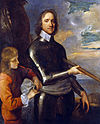 Oliver Cromwell |
London | The earliest known reference to cricket in London concerns the future Lord Protector, who played the game there when training at the Inns of Court.[7] |
| 1622 | Edward Hartley | Boxgrove, Sussex | All were prosecuted for "breaking the Sabbath" by playing cricket on a Sunday.[5][8] |
| Anthony Ward | |||
| Raphe West | |||
| Richard Martin Sr | |||
| Richard Martin Jr | |||
| Richard Slaughter | |||
| Thomas West | |||
| William Martin | |||
| 1624 | Jasper Vinall | West Hoathly, Sussex | Vinall died as the result of an injury during a game, caused by a blow on the head from Tye's bat; he is the sport's earliest known fatality. The inquest ruled death by misadventure.[9][8] |
| Edward Tye | |||
| 1628 | Edward Taylor | East Lavant, Sussex | Both were prosecuted for "breaking the Sabbath" by playing cricket on a Sunday.[10][11] |
| William Greentree | |||
| 1629 | Henry Cuffin | Ruckinge, Kent | Prosecuted for "breaking the Sabbath" by playing cricket on a Sunday, Cuffin retorted that cricket was "a game played by persons of repute and fashion".[2][12] |
| 1631 | Rev. Thomas Wilson | Maidstone, Kent | A Puritan minister who described people playing cricket and other games as "prophane".[13][14] |
| 1634 | Rev. Richard Culmer | Harbledown, Kent | A Puritan minister, known as "Blue Dick", who alienated his parishioners by seeking to suppress cricket and drunkenness in the community.[15] |
| 1636 | Henry Mabbinck | West Horsley, Surrey | Testified in a tithe dispute that cricket was played "in the Parke" at West Horsley.[16] |
| 1640 | Robert Spilstead | Chevening, Kent | As the plaintiff in a trespass case, Spilstead testified that there was "about thirty years since a cricketting between the Weald and Upland and the Chalkehill". This match played c.1610 is the earliest known organised match on record.[17] |
| 1646 | Samuel Filmer | Coxheath, Kent | Filmer and Harlackenden played and defeated the other four but had to resort to litigation when their winnings were not paid.[17] Filmer lived in Virginia during the Commonwealth of England. One of his relations was a governor of the colony and Rowland Bowen has speculated that Filmer played cricket there. There is a possible connection between these Filmers and President Millard Fillmore.[18] |
| Thomas Harlackenden | |||
| Richard Marsh | Maidstone, Kent | ||
| Robert Sanders | |||
| Walter Franklyn | |||
| William Cooper | |||
| 1647 | Henry Brand | Selsey, Sussex | Brand was killed after being struck on the head by Latter's bat during a game.[10] John Major has suggested that Thomas Latter was a relation of Richard Latter (see 1611).[6] |
| Thomas Latter | |||
| Robert Mathew | Winchester College, Hampshire | Author of a Latin poem which contains a probable reference to cricket being played at Winchester College; if so, it is the earliest known mention of cricket in Hampshire.[19][20] | |
| 1652 | John Rabson | Cranbrook, Kent | Prosecuted for "breaking the Sabbath" by playing cricket on a Sunday.[21] |
| 1658 | Edward Phillips | London | The earliest reference to the ball is found in his poem Mysteries of Love and Eloquence.[7][2][22] |
| 1665 | 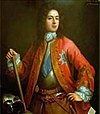 John Churchill, 1st Duke of Marlborough |
St Paul's School, London | Churchill attended the school as a teenage pupil in the 1660s and is known to have played cricket there. Following Cromwell in 1617, this is the second known reference to cricket in London and both concern young men who became famous generals.[23] |
| 1666 | 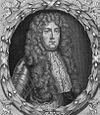 Sir Robert Paston |
Richmond, Surrey | In a letter, Paston mentioned a "cricketting" on Richmond Green.[24] |
| 1671 | Edward Bound | Shere, Surrey | Prosecuted for "breaking the Sabbath" but he was exonerated.[25] |
| 1673 | Thomas Salmon | University of Oxford | In the earliest reference to cricket at Oxford, Salmon is criticised for his love of the game by his rival John Phillips.[26] |
| 1676 | Henry Tonge | British Mission, Aleppo, Turkey | Provided the earliest known record of cricket being played outside England.[27][28] |
| 1677 | Thomas Lennard, 1st Earl of Sussex | Herstmonceux, East Sussex | His personal accounts refer to him receiving £3 before he attended a match at "ye Dicker", a common near Herstmonceux.[29] |
| 1694 | Sir John Pelham | Lewes, Sussex | His personal accounts refer to him paying 2s.6d. after he lost a wager when he attended a match at Lewes.[28] |
1701 to 1725
In the 18th century tables, the third column is headed "team" because there is greater knowledge of clubs and other team names. If an entry is in brackets, however, it refers to a known location as in the 1597 to 1700 table. For example, in 1702, the 1st Duke of Richmond is associated with county cricket in Sussex; in 1706, William Goldwin was not a known player but he was resident in Bristol.
| year | name | team | notes[c][d] |
|---|---|---|---|
| 1702 |  Charles Lennox, 1st Duke of Richmond |
Sussex | The sport's earliest known leading patron.[30] |
| 1706 | William Goldwin | (Bristol) | Goldwin wrote a Latin poem of 95 lines on a rural cricket match. It was called In Certamen Pilae (On a Ball Game) and it was published in his Musae Juveniles.[31][32] |
| 1709 | William Bedle | Dartford and Kent | Bedle's 1768 obituary states that he was the "most expert cricket player in England". It is possible that he played for Dartford/Kent against a Surrey team in 1709.[33][34] |
| William Byrd II | (Virginia) | An American lawyer who was educated at Felsted School in Essex, Byrd is known to have organised cricket matches on his James River estates in the Colony of Virginia.[35] This is the earliest reference to cricket being played in the New World.[36][18] | |
| 1717 | Thomas Marchant | (Hurstpierpoint), Sussex | Perhaps not a player himself, though his son Will was, Marchant was a Sussex farmer who kept a diary in which he made numerous references to cricket from 1717 to 1727.[37] |
| 1724 | Edwin Stead | Kent | A leading patron of Kent cricket who died young in 1735.[38][39] |
| William Goodwin | Sunbury and Middlesex | Described as "able to play at Cricket with most People". Sunbury had a noted team.[40] | |
| 1725 | Sir William Gage, 7th Baronet | Slindon and Sussex | The two leading patrons of Sussex cricket in general and of the Slindon club in particular. The earliest known reference to both in a cricket connection is a letter sent by Gage to Richmond in July 1725.[41][42] |
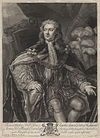 Charles Lennox, 2nd Duke of Richmond |
|||
| Edmund Chapman | Chertsey and Surrey | His 1763 obituary described him as "one of the most dextrous cricket players in England".[43] |
1726 to 1740
| year | name | team | notes[c][d] |
|---|---|---|---|
| 1726 | Perry | London | Both took part in the earliest known single wicket match. The players were well known as the contemporary report calls them "the noted Perry of London and the famous Piper of Hampton".[44] |
| Piper | Hampton | ||
| 1727 | Alan Brodrick, 2nd Viscount Midleton | Surrey | A Surrey patron who was partly responsible for drawing up the first known rules of the game.[45] |
| Thomas Waymark | Sussex and Berkshire | Accounted the first great all-rounder, Waymark played for over 20 years and was noted for his "extraordinary agility and dexterity".[46] | |
| 1728 | César-François de Saussure | (Swiss writer) | Not an Englishman but, in June 1728, de Saussure noted in his journal the frequency with which he saw cricket being played while he was making journeys across southern England. He referred to county matches as "a commonplace" and wrote that "everyone plays it, the common people and also men of rank".[47] |
| 1729 | John Chitty |
Surrey | The owner of what is now the world's oldest surviving cricket bat (pictured), which is kept in the museum at The Oval.[48] |
| 1730 | Mr Andrews | Sunbury and Surrey | A Surrey patron who challenged the Duke of Richmond's team in 1730.[49] |
| 1731 | 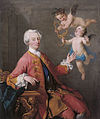 Frederick, Prince of Wales |
Surrey | Heir to the throne who became very interested in cricket when he first came to England from Hanover and was a leading patron for the rest of his life.[50] |
| Tim Coleman | London | Described in a contemporary report as "the famous Tim Coleman".[50] | |
| Captain Beak | none | Both took part in an early single wicket contest, though it was a minor event.[51] | |
| Lieutenant Coke | |||
| Thomas Chambers | Middlesex | A Middlesex patron who challenged the Duke of Richmond's team in 1731.[51] | |
| 1732 | Christopher Jones | London | Keeper of the Artillery Ground.[52] |
| 1734 | Charles Sackville, Lord Middlesex | Kent | An occasional patron of Kent cricket.[53] |
| Lord John Philip Sackville | Kent | A leading patron of Kent cricket who was also a noted player.[53] | |
| 1735 | Cook | (Brentford) | Described by a contemporary reporter as "one of the best bowlers in England".[54] |
| Dunn | London | Evidently a top order batsman who is mentioned in three match reports.[54] | |
| Ellis | Described by a contemporary reporter as London's "best bowler".[54] | ||
| Wakeland | Made two known appearances in single wicket contests.[55] | ||
| Wheatley | Evidently a top order batsman, known to have been a distiller by trade.[54] | ||
| Marshall | Recorded in one match in 1735.[56] | ||
| Pool | Recorded in one match in 1735.[56] | ||
| Mr Jervoise | Croydon and Surrey | A Surrey patron who was active in 1735.[57] | |
| Wood | (Woodcot), Surrey | Mentioned briefly in a 1735 report. There were apparently two Woods of Woodcot.[54] | |
| 1736 | George Oldner | London | Appeared in a top-class single wicket contest in 1736.[55] |
| 1737 | John Boots | Sussex | Village cricket player who died during a match after colliding with another player.[58] |
 Charles Spencer, 3rd Duke of Marlborough |
London | Patron and team captain.[59] | |
| 1739 | John Bowra | Bromley | Known as the "Kentish Shepherd" and believed to be the father of William Bowra.[60] |
| 1740 | Darville | Berkshire | Apparently Thomas Waymark's employer at Bray Mills in Berkshire. A patron who is recorded playing in three single wicket matches in 1748.[61] |
| John Newland | Slindon | Brother of Richard Newland. First mentioned in correspondence to Thomas Pelham-Holles, 1st Duke of Newcastle by the 2nd Duke of Richmond as someone "that you must remember".[62] | |
| George Smith | London | A publican who was also the groundkeeper of the Artillery Ground. Although he was an occasional player, he was better known for his financial problems and his battles against bankruptcy.[63] | |
1741 to 1745
| year | name | team | notes[c][d] |
|---|---|---|---|
| 1741 | John Russell, 4th Duke of Bedford | Bedfordshire | Patron and captain of his county team.[64] |
| George Montagu-Dunk, 2nd Earl of Halifax | Northamptonshire | Patron and captain of his county team.[64] | |
| John Montagu, 4th Earl of Sandwich | Huntingdonshire | Patron and captain of his county team.[64] | |
| Richard Grenville-Temple, 2nd Earl Temple | Buckinghamshire | Patron and captain of his county team.[65] | |
| 1743 | Richard Newland | Slindon | One of the most outstanding players of the sport's pioneering era before the introduction of the pitched delivery. Made the highest known individual score of the period.[66] |
| John Bryant | Bromley and Kent | Brother of James Bryant. One of the best players for the Kent county team and a key member of Bromley Cricket Club.[67] | |
| John Cutbush | (Maidstone) and Kent | Rated among "the six best players in England".[67] | |
| Ridgeway | Sussex | Rated among "the six best players in England".[67] | |
| Robert Colchin aka "Long Robin" | Bromley and Kent | A controversial figure who was held to be both the best batsman and all-rounder of his time. An outstanding single wicket player and a very influential match organiser.[68] | |
| Tom Peake | (Chelsfield) and Kent | Recorded in two top-class matches in 1743 and 1749.[68] | |
| Val Romney | (Sevenoaks) and Kent | Noted for his leadership and described by James Love as "a mighty player".[67] | |
| William Hodsoll | Dartford and Kent | An outstanding bowler who was rated among "the six best players in England".[67] | |
| William Sawyer | (Richmond) and Surrey | Rated among "the six best players in England".[67] | |
| Henry Bromley, 1st Baron Montfort | London | Patron and team captain who led the London, Middlesex & Surrey XI in May 1743.[69] | |
| Stephen Rose | Chertsey | An army deserter reported to be "a famous cricket player".[70] | |
| 1744 | Adam Newland | Slindon | Brother of Richard Newland. Noted member of the Slindon team.[66] |
| Little Bennett | London | Probably brothers and noted in contemporary reports to have been two of the best batsmen of their time.[63] | |
| Tall Bennett | |||
| Collins | Surrey | Mentioned in 1744 and 1748; played for London against Slindon in the earliest match that has a surviving scorecard.[63] | |
| Edward Aburrow Sr aka "Cuddy" | Slindon and Sussex | A known smuggler who played under his alias to disguise himself. Father of the Hambledon player of the same name, he is recorded in matches to 1751. A noted bowler and single wicket player. Father of Edward Aburrow Jr.[63] | |
| George Jackson | Addington and Surrey | Known to have been a good batsman who frequently played in single wicket contests, he is recorded in matches to 1752.[63] | |
| Green | (Amberley) and Sussex | Recorded in three matches to 1747.[63] | |
| Howlett | London | Made two known appearances in 1744 and 1745.[63] | |
| James Bryant | Bromley and Kent | Brother of John Bryant. One of the best players for the Kent county team and a key member of Bromley Cricket Club.[63] | |
| James Love | Richmond | A playing member at Richmond but better known as a poet.[71] | |
| Joe Harris | Addington and Surrey | Brother of John Harris and recorded until 1756. Made 26 known appearances in single wicket and 15 in eleven-a-side matches.[63] | |
| John Harris | Addington and Surrey | Brother of Joe Harris and recorded until 1754. Made 11 known appearances in single wicket and 12 in eleven-a-side matches.[63] | |
| John Mills | (Horsmonden) and Kent | A noted bowler but is only recorded in one match.[71] | |
| Kipps | (Eltham) and Kent | A noted wicketkeeper who is recorded four times to 1747.[71] | |
| Maynard | Surrey | Recorded in 12 matches to 1750.[63] | |
| Norris | London | Made two known appearances in 1744 and 1745.[63] | |
| Stephen Dingate | (Reigate), Surrey | Believed to have been a barber by trade, one of the leading single wicket players of the 1740s.[63] | |
| Stevens | Surrey | Two players called Stevens were due to play in the London v Slindon match on 2 June 1744 but did not take part and are not mentioned in other sources.[63] | |
| Tom Faulkner | Addington and Surrey | A prominent single wicket player who is recorded to 1761. Was also a prizefighter who fought under the sobriquet of "Long Tom".[63] | |
| Andrews | Slindon and Sussex | Recorded in one match in 1744.[63] | |
| Bartram | Kent | Recorded in one match in 1744.[71] | |
| Butler | London | Recorded in one match in 1744.[63] | |
| Danes | Kent | Recorded in one match in 1744.[71] | |
| Hodder | London | Recorded in one match in 1744.[63] | |
| Mills | Kent | Possibly John Mills' brother; recorded in one match in 1744.[71] | |
| 1745 | Broad | Addington and Surrey | Mentioned in match reports from 1745 to 1750.[72] |
| Howard | Kent | Mentioned in match reports from 1745 to 1752.[72] | |
| Robert Lascoe | Bromley and Kent | Mentioned in match reports from 1745 to 1748.[72] | |
| William Anderson | London | Mentioned in match reports from 1745 to 1752. It is believed a benefit match was held for him in 1753.[72] | |
| Hodge | Long Robin's XI | Recorded in one match in 1745.[72] | |
| Jacob Mann | Richard Newland's XI | Recorded in one match in 1745.[72] | |
| Martin | Richard Newland's XI | Recorded in one match in 1745.[72] | |
| Norton | Richard Newland's XI | Recorded in one match in 1745.[72] |
1746 to 1760
| year | name | team | notes[c][d] |
|---|---|---|---|
| 1747 | John Bell | Dartford and Kent | Noted wicketkeeper.[73] |
| Thomas Bell | Dartford and Kent | Brother of the above. Condemned to death in 1762 but later reprieved.[73] | |
| John Mansfield | Sevenoaks and Kent | Batsman noted for single wicket appearances.[73] | |
| John Larkin | Hadlow and Kent | Noted single wicket performer.[73] | |
| Jones | Hadlow and Kent | Mentioned in match reports from 1747 to 1749.[73] | |
| Joseph Rudd | Sussex | Noted single wicket performer.[74] | |
| Pye | Sussex | Noted single wicket performer.[74] | |
| Robert Eures | (Bexley) and Kent | Known to have been a good batsman who played for England teams.[73] | |
| Thomas Jure | London | Mentioned in match reports from 1747 to 1749.[73] | |
| Allen | Kent | Recorded in one match in 1747.[73] | |
| 1748 | Durling | Addington and Surrey | Mentioned in match reports from 1748 to 1761.[61] |
| John Capon | London and Surrey | Mentioned in match reports from 1748 to 1755.[61] | |
| George Carter | London | Recorded four times from 1748 to 1749.[61] | |
| Walker | London | Recorded in one single wicket match in 1748.[61] | |
| 1749 | John Frame | Dartford and Kent | Arguably the first great fast bowler in cricket history and had a long career from 1749 to at least 1774.[75][76] |
| Perry | Surrey | Mentioned in match reports from 1749 to 1755. Has been confused with the 1726 player, who could have been a relation.[76] | |
| Humphreys | Surrey | Recorded in two matches in 1749.[76] | |
| John Colchin | Bromley | Probably Robert Colchin's brother; recorded in two matches in 1749.[76] | |
| Joseph Hitches | Long Robin's XI | Recorded three times in 1749.[76] | |
| Thomas Southam | Long Robin's XI | Recorded three times in 1749.[76] | |
| Robinson | (Tom Faulkner's XI | Recorded three times in 1749.[76] | |
| 1750 | Garrett | Kent | Recorded in five matches from 1750 to 1751.[77] |
| Rawlings | Kent | Mentioned in three match reports to 1751.[77] | |
| Robert Bartholomew | Surrey | Possibly part of a cricketing family, he was also an innkeeper.[77] | |
| Thomas Brandon | Dartford and Kent | A noted batsman who was mentioned in match reports from 1750 to 1759.[77] | |
| Frame | Surrey | John Frame's brother; recorded in three matches in 1750.[77] | |
| 1751 | Stephen Harding | (Thursley) and Chertsey | Hard-hitting batsman mentioned in match reports from 1751 to 1765.[78] |
| Stephens | Dartford | Mentioned in match reports from 1751 to 1759.[78] | |
| Mathews | England | Recorded in two matches in 1751.[78] | |
| Stone | Kent | Recorded in two matches in 1751.[78] | |
| Wilden | Kent | Recorded in two matches in 1751.[78] | |
| 1753 | William King | London | Noted as a leading London player in 1753 and 1754.[79] |
| 1754 | Parr | (Chatham) | Recorded in one single wicket match in 1754.[80] |
| 1755 | Clowder | London | Recorded in one single wicket match in 1755.[61] |
| 1759 | Gill | (Buckinghamshire) and England | Noted wicketkeeper who was still playing in 1772.[81] |
| John Edmeads | Chertsey and Surrey | Mentioned in match reports until 1779.[82] | |
| John Haynes | Surrey | Mentioned in match reports from 1759 to 1761.[81] | |
| Thomas Woods | Chertsey and Surrey | Only definite reference is in 1761 but probably played in 1759 for England. There is confusion in sources with other players named "Woods", "John Wood" and "Thomas Wood".[81] | |
| Allen | Middlesex | Played in three matches in 1759. No other mentions.[81] | |
| Burchwood | Kent | Noted bowler. Played in three matches in 1759.[81] | |
| Cheeseman | Sussex | Played in three matches in 1759. No other mentions.[81] | |
| Gascoigne | London | Played in three matches in 1759. No other mentions.[81][83] | |
| Nyland | Sussex | Played in three matches in 1759. No other mentions. Possibly Richard Newland or Richard Nyren.[81] | |
| Saunders | Berkshire | Played in three matches in 1759. No other mentions.[81] | |
| Goldstone | Dartford and Kent | Played in three matches in 1759. No other mentions.[81] | |
| Killick | Dartford and Kent | Played in three matches in 1759. No other mentions.[81] | |
| Potter | Dartford and Kent | Played in three matches in 1759. No other mentions.[81] | |
| Wakelin | Dartford and Kent | Played in three matches in 1759. No other mentions.[81] |
1761 to 1771
| year | name | team | notes[c][d] |
|---|---|---|---|
| 1761 | Shock White | Brentford | Definitely active between 1761 and 1773 but often confused with Thomas "Daddy" White.[84] |
| Charles Sears | Chertsey | Played two matches in 1761.[84] | |
| William Piper | Chertsey | Appeared in one match in 1761 as a given man for Chertsey.[84] | |
| 1764 | 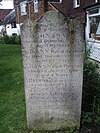 John Small |
Hambledon and Hampshire | Described by John Nyren as "a star of the first magnitude",[85] master batsman John Small is buried in St Peter's churchyard (pictured) in his home village of Petersfield.[86] |
| John Bayton | Hambledon and Hampshire | Noted batsman of the late 1760s whose career apparently ended in the early 1770s.[87] | |
| Peter Stewart | Hambledon and Hampshire | Nicknamed "Buck", a humorist who was a Hambledon mainstay through the club's formative period.[82] | |
| Richard Nyren | Hambledon and Hampshire | Cricket's earliest known left-hander. An outstanding all-rounder who captained the Hambledon team in its heyday.[81] | |
| Squire Thomas Land | Hambledon and Hampshire | Perhaps the original patron of Hambledon cricket who seems to have left the scene before the club was founded.[87] | |
| Thomas Baldwin | Chertsey | Active in the 1760s.[88] | |
| Thomas Ridge | Hambledon and Hampshire | Prominent Hambledon Club member who played in a number of matches to 1775.[87] | |
| William Barber | Hambledon and Hampshire | Noted bowler, probably fast-medium, who played until 1777.[89] | |
| William Hogsflesh | Hambledon and Hampshire | Noted bowler, probably fast-medium, who played until 1775.[90] | |
| Edward Woolgar | Hambledon and Hampshire | Tentative reference re one match in 1764.[87] | |
| John Woolgar | Hambledon and Hampshire | Tentative reference re one match in 1764.[87] | |
| Osmond | Hambledon and Hampshire | Tentative reference re one match in 1764.[87] | |
| 1765 | Richard Edmeads | Chertsey | Brother of John Edmeads; recorded in one match in 1765.[91] |
| 1767 | Edward Aburrow Jr aka "Curry" | Hambledon and Hampshire | Son of Edward Aburrow Sr. A Hampshire regular to 1782.[92] |
| Henry Rowett | Caterham and Surrey | Patron of Surrey cricket who was chiefly associated with the Caterham club in the 1760s.[33] | |
| Sir Horatio Mann, 2nd Baronet | Kent | A leading patron of Kent cricket.[92] | |
| Tom Sueter | Hambledon and Hampshire | Outstanding wicketkeeper-batsman, especially noted for his front foot play.[93] | |
| 1768 | 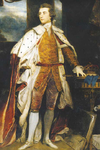 John Frederick Sackville, 3rd Duke of Dorset |
Kent | A leading patron of Kent cricket and a useful player in his own right.[94][95] |
| Bellchambers | Surrey | Recorded in two matches to 1769.[94] | |
| James Fuggles | Kent | Kent batsman who was last recorded in 1773.[94] | |
| John Boorman | Kent and Essex | Prominent bowler active until 1793.[81] | |
| Joseph Miller | Kent | Outstanding batsman who was active until 1783. Some confusion exists re his first name but the majority of sources call him Joseph.[33][96] | |
| Richard May | Kent | Noted bowler of the 1760s and 1770s. Brother of Thomas May.[97] | |
| Thomas May | Kent | Batsman who played until 1773. Brother of Richard May.[97] | |
| Richard Simmons | Kent | One of the earliest well-known wicketkeepers. Active until 1779.[33] | |
| Will Palmer | Kent and Surrey | Noted batsman who was active from the 1760s until 1784.[33] | |
| Birchet | Surrey | Recorded in two matches in 1768.[94] | |
| Brobham | Dartford and Kent | Recorded in one single wicket match in 1768 and a match for Dartford in 1775.[94] | |
| Foule | Caterham | Recorded as top scorer in one match in 1768.[33] | |
| Mandy | Kent | Recorded in one single wicket match in 1768.[94] | |
| Muddle | Kent | Recorded in two matches in 1768.[94] | |
| Smailes | Caterham | Recorded in two matches from 1768 to 1769.[33] | |
| Blake | Caterham | Tentative reference re one match in 1768.[33] | |
| Carpenter | Caterham | Tentative reference re one match in 1768.[33] | |
| Edward Francis | Caterham | Tentative reference re one match in 1768.[33] | |
| T. Francis | Caterham | Tentative reference re one match in 1768.[33] | |
| Golding | Bourne | Tentative reference re one match in 1768.[33] | |
| Love | Bourne | Tentative reference re one match in 1768.[33] | |
| Miller | Caterham | Tentative reference re one match in 1768.[33] | |
| Twinker | Caterham | Tentative reference re one match in 1768.[33] | |
| Ward | Bourne | Tentative reference re one match in 1768.[33] | |
| 1769 | Lumpy Stevens | Chertsey and Surrey | One of the greatest bowlers of the underarm era. Had a long career from c. 1756 to 1789.[98] |
| Jasper Fish | Kent | Recorded in three matches between 1769 and 1777.[99] | |
| John Wood (Kent) | Kent | Noted bowler who was active until 1783. Sources have often failed to disambiguate him re John Wood of Surrey.[99] | |
| George Leer | Hambledon and Hampshire | Middle order batsman who was mainly noted for his fielding.[92] | |
| John Minshull | Kent and Surrey | Scorer of the earliest known century in all forms of cricket and a noted batsman in the 1760s and 1770s.[100] | |
| Thomas Brett | Hambledon and Hampshire | Outstanding fast bowler who was acclaimed for his combination of speed and accuracy.[101] | |
| Page | Chertsey and Surrey | Active until 1773.[99] | |
| Thomas Pattenden | Kent | Played in over thirty matches from 1772 to 1783. In some scorecards, he cannot be differentiated from his brother William.[99] | |
| Thomas Quiddington | Chertsey and Surrey | Noted bowler mentioned in reports from 1769 to 1784. His name has also been spelt Quiddenden.[99] | |
| John Wood (Surrey) | Chertsey and Surrey | Noted all-rounder who was active until 1780. Sources have often failed to disambiguate him re John Wood of Kent and S&B always calls him Thomas Wood.[99] | |
| William Bowra | Kent and Sussex | Probably the son of John Bowra. Sound middle-order batsman who is believed to have been a good close fielder.[102] | |
| Glazier | Hambledon and Hampshire | Recorded in one match in 1769.[99] | |
| Purdy | Hambledon and Hampshire | Recorded in one match in 1769.[99] | |
| Shepherd | Caterham and Surrey | Recorded in one match in 1769.[99] | |
| Wessing | Caterham and Surrey | Recorded in one match in 1769.[99] | |
| S. Bartram | Duke of Dorset's XI | Recorded in one match in 1769.[103] | |
| Bishop | Duke of Dorset's XI | Recorded in one match in 1769.[103] | |
| Oliver | Duke of Dorset's XI | Recorded in one match in 1769.[103] | |
| Shearcy | Duke of Dorset's XI | Recorded in one match in 1769.[103] | |
| Whitting | Duke of Dorset's XI | Recorded in one match in 1769.[103] | |
| 1771 | Coleman | Nottingham | Two known matches, 1771–72.[104] |
| Collishaw | Nottingham | Two known matches, 1771–72.[104] | |
| Reverend Reynell Cotton | Hambledon | An educator who was the president of the Hambledon Club in 1773 and 1774. He is believed to have played in the 1750s. Best known for composing the Hambledon Club Song c. 1771.[105] | |
| John de Burgh, 13th Earl of Clanricarde | Hambledon and Hampshire | Occasional player in the early 1770s. Became the 13th Earl of Clanricarde.[106] | |
| Huythwaite | Nottingham | One match against Sheffield.[104] | |
| Loughman | Nottingham | Two known matches, 1771–72.[104] | |
| Mew | Nottingham | Two known matches, 1771–72.[104] | |
| Osguthorpe | Sheffield | One match against Nottingham.[104] | |
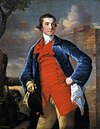 Harry Peckham |
Sussex | Occasional player who was a member of the Laws committee in 1774.[106] | |
| Rawson | Nottingham | One match against Sheffield.[104] | |
| Roe | Nottingham | Two known matches, 1771–72.[104] | |
| Spurr | Nottingham | Two known matches, 1771–72.[104] | |
| Stocks | Nottingham | Two known matches, 1771–72.[104] | |
| Troop | Nottingham | Two known matches, 1771–72.[104] | |
| Turner | Nottingham | Two known matches, 1771–72.[104] | |
| Thomas White | Chertsey and Surrey | Noted all-rounder who instigated the 1771 Monster Bat Incident. Retired in 1779.[107] |
1772 to 1775
| year | name | team | notes[c][d] |
|---|---|---|---|
| 1772 | Childs | Surrey | Recorded in nine matches from 1772 to 1774 but believed to have been active long before 1772.[108] |
| Bamford | Nottingham | One match against Sheffield.[104] | |
| Mr Ellis | Hampshire and Sussex | A now unknown figure who was mentioned as the subject of a bet re how many runs he might score in comparison with the Duke of Dorset in a Kent versus Hampshire and Sussex match.[109] | |
| Gladwin | Nottingham | One match against Sheffield.[104] | |
| William Yalden | Chertsey and Surrey | Outstanding wicketkeeper-batsman. Made at least fifty known appearances to 1783.[110] | |
| 1773 | William Bartholomew | Chertsey and Surrey | A member of the Bartholomew family, recorded in 1773.[111] |
| Charles Bennet, 4th Earl of Tankerville | Surrey | A leading patron of Surrey cricket who employed Lumpy as a gardener.[112] | |
| Charles Powlett | Hambledon Club | A key benefactor and patron at Hambledon. A member of the Laws committee in 1774.[113] | |
| Constantine Phillips | Surrey | Made 5 known appearances to 1778.[111] | |
| Edward Hussey | Kent | A useful batsman who had a long but sporadic career from 1773 to 1797.[114] | |
| Francis Booker | Kent | Left-handed batsman and noted fielder who played regularly until 1790.[108] | |
| George Louch | Kent | An occasional patron who was one of the most prolific amateur players.[115] | |
| Henry Attfield | Surrey | Also known as "Field", his career seems to have ended early at age 26 in 1782.[111] | |
| James Aylward | Hambledon and Hampshire | Noted batsman who had a long career and made a known record score of 167 in 1777.[116] | |
| James Bayley | Hambledon and Hampshire | Made four known appearances from 1773 to 1783.[111] | |
| John Wheeler | Kent | Made two known appearances in 1773 and 1775.[111] | |
| M. Lewis | Surrey | Amateur who made two known appearances in 1773.[111] | |
| Richard Francis | Hambledon and Hampshire | Regular player for Hampshire until 1793.[108] | |
| Richard Newman | Essex and Kent | Amateur batsman who was active from 1773 to 1793.[111] | |
| Richard Purchase | Hambledon and Hampshire | Noted slow bowler who had a long career from 1773 until 1803, though he was absent from 1775 to 1780 inclusive.[111] | |
| Samuel Colchin | Kent | All-rounder who was active until 1779. Nephew of Robert Colchin.[111] | |
| John Brewer Davis | Kent | Recorded twice in 1773.[111] | |
| Robert Stone | Surrey | Amateur batsman who played eight times until 1780. May have reappeared in 1790, if the same man.[111] | |
| T. Davis | Hambledon and Hampshire | Amateur batsman who made 7 known appearances for Hampshire until 1776.[111] | |
| William Bullen | Kent | Outstanding all-rounder who was prolific until 1800. First bowler ever to be definitely credited with 5 wickets in an innings.[116] | |
| Blake | Surrey | Recorded in one match in 1773.[111] | |
| Horne | Hambledon | Recorded in one match for "Hambledon Town" in 1773.[111] | |
| James Cotton | Hambledon | Recorded in one match for "Hambledon Town" in 1773.[111] | |
| Lawrence | Hambledon | Recorded in two matches only (1773/77).[111] | |
| M. Lewis | Hambledon | Recorded in one match for "Hambledon Town" in 1773.[111] | |
| Read | England | Recorded in one match in 1773.[111] | |
| 1774 | Muggeridge | Chertsey and Surrey | Bowler who was active until 1784.[75] |
| Waller | Kent | Recorded in two matches in 1774.[75] | |
| William Brazier | Kent | All-rounder who played from 1774 to 1794 but was absent 1777–1781.[75] | |
| Richard Miller | Surrey | Possibly a brother of Joseph Miller; recorded in one match in 1774.[75] | |
| 1775 | Tom Taylor | Hampshire | Outstanding all-rounder, especially noted for the cut shot and brilliant fielding.[90] |
| William Edmeads | Surrey | Younger brother of John Edmeads. Recorded in one match in 1775.[117] | |
| Francis | Hampshire | Possibly a brother of Richard Francis; recorded in one match in 1775.[118] | |
| Rev. Charles Bartholomew | Chertsey | One of the Bartholomew family who played in the 1770s and perhaps earlier.[119] | |
| Thomas Swayne | Chertsey | Made three recorded appearances to 1778.[119] | |
| Briggs | (Risborough) | Recorded as a given man in one match in 1775.[120] | |
| Daniel Etheridge | Chertsey | Recorded in three matches in 1775.[119] | |
| Faggoter | Chertsey | Recorded in one match in 1775.[119] | |
| Richard Lipscomb | Chertsey | Recorded in two matches in 1775.[119] | |
| Ashby aka Ashley | Coulsdon | Amateur player; recorded in one match in 1775.[119] | |
| Benick | Coulsdon | Recorded in one match in 1775.[119] | |
| Burkin | Coulsdon | Recorded in one match in 1775.[119] | |
| Henry Palmer | Coulsdon | Recorded in one match in 1775; possibly related to Will Palmer.[119] | |
| Bassden | London | Recorded in two matches (1775/77).[119] | |
| Birdeye | London | Recorded in one match in 1775.[119] | |
| Warren | London | Recorded in one match in 1775.[119] | |
| Baldwin | Dartford | Recorded in one match in 1775.[119] | |
| Hammond | Dartford | Recorded in one match in 1775.[119] | |
| Scuder | Dartford | Recorded in one match in 1775.[119] | |
| Goulson | Dartford | Recorded in one match in 1775.[119] | |
| Lintot | Dartford | Recorded in one match in 1775.[119] | |
| Sanham | Dartford | Recorded in one match in 1775.[119] | |
| Terry | Dartford | Recorded in one match in 1775.[119] | |
| Richardson | Dartford | Recorded in one match in 1775.[119] |
1776 to 1780
| year | name | team | notes[c][d] |
|---|---|---|---|
| 1776 | Richard Aubrey Veck | Hampshire | Noted batsman who was a Hampshire regular until 1784 when he quit the game for, apparently, business reasons.[102] |
| 1777 | Lamborn | Surrey and Hampshire | Spin bowler who was a great innovator. Known as the "Little Farmer".[121] |
| Mills | Surrey | Bowler who was active until 1781.[122] | |
| Noah Mann | Hampshire | Outstanding all-rounder noted for his athleticism. Career ended tragically when he was killed by fire.[89] | |
| Pennell | Kent | Made five known appearances to 1781.[123] | |
| Richard Hosmer | Kent | Amateur batsman. Active until 1791.[100] | |
| Richard Stanford | Kent | Amateur batsman. Active until 1787.[100] | |
| Robert Clifford | Kent | Prolific all-rounder, especially noted for his slow bowling. Active until 1792.[121] | |
| Townsend | Kent | Recorded in seven matches to 1786.[124] | |
| William Bedster | Surrey and Middlesex | Noted batsman who played regularly to 1794. Was at one time the Earl of Tankerville's butler.[123] | |
| William Pattenden | Kent | Occasional player to 1781. Younger brother of Thomas Pattenden.[100] | |
| Baker | Hampshire | Recorded in one match in 1777.[123] | |
| Holness | Kent | Recorded in one match in 1777 and in one match in 1781.[125] | |
| Bidewell | Kent | Recorded in one match in 1777.[125] | |
| Oakley | Kent | Recorded in one match in 1777.[125] | |
| 1778 | Boltwood | England | Recorded in one match in 1778.[126] |
| Henry Bonham | Hampshire | Amateur player; recorded in one match in 1778.[122] | |
| Irons | England | Recorded in one match in 1778.[126] | |
| Mansfield | England | Recorded in one match in 1778.[126] | |
| Polden | England | Recorded in one match in 1778.[126] | |
| 1779 | Berwick | Surrey and Hampshire | Made 6 known appearances from 1779 to 1780.[127] |
| 1780 | Gibson | Kent | Mentioned in two matches in 1780.[100] |
| John Freemantle | Hampshire | Elder brother of Andrew Freemantle. A fast bowler who had a short career to 1782.[128] | |
| B. Rimmington | Kent | One of three brothers who collectively played until 1791. Sources often fail to disambiguate between them.[100] | |
| T. Rimmington | Kent | One of three brothers who collectively played until 1791. Sources often fail to disambiguate between them.[100] |
1781 to 1787
| year | name | team | notes[c][d] |
|---|---|---|---|
| 1781 | Hogben | Kent | Made six known appearances in 1781 and 1782.[112] |
| J. Martin | Essex | Professional bowler active until 1793.[112] | |
| M. Rimmington | Kent | One of three brothers who collectively played until 1791. Sources often fail to disambiguate between them.[100] | |
| Webb | Kent | Made five known appearances in 1781.[112] | |
| Hodges | Kent | Recorded in one match in 1781.[112] | |
| T. Skinner | Hampshire | Recorded in one match in 1781.[112] | |
| 1782 | David Harris | Hampshire | One of the greatest bowlers of the underarm era. Active to 1798.[129] |
| "Little" Joey Ring | Kent | Noted batsman who played until 1796.[129] | |
| W. Hall | Hampshire | Recorded in one match in 1782.[129] | |
| 1783 | Couchman | Kent | Made two known appearances to 1786.[124] |
| James Wells | Surrey | Brother of the more famous John Wells. Made over twenty known appearances to 1800.[95] | |
| Stephen Amherst | Kent | An occasional patron of Kent cricket who was Thomas Boxall's employer.[124] | |
| 1784 | J. Cole | Hampshire | Two known appearances to 1788.[130] |
| Davidson | Essex | Three known appearances to 1787.[130] | |
| Jack Small | Hampshire | Son of John Small and close friend of John Nyren. A sound batsman but overshadowed by his father.[130][131] | |
| Harry Walker | Hampshire and Surrey | Brother of Tom Walker recorded until 1802. Batsman who was noted for his use of the cut shot.[132] | |
| 1785 | 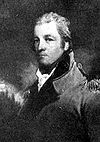 Charles Lennox, 4th Duke of Richmond |
White Conduit Club (WCC) |
Acted as Thomas Lord's guarantors and became significant patrons during the early years of MCC.[133] |
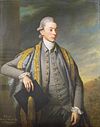 George Finch, 9th Earl of Winchilsea |
|||
| Barker | Essex | Amateur player. Recorded in four matches to 1793.[134] | |
| John Dampier | WCC | Amateur player. Recorded in three matches to 1787.[135] | |
| Lord Strathavon | WCC | Amateur player. Recorded in three matches to 1792. Later styled as George Gordon, 9th Marquess of Huntly.[135] | |
| George Henry Monson | WCC | Amateur player. Recorded in ten matches to 1792.[132] | |
| Charles Monson | WCC | Amateur player. Brother of G. H. Monson. Army captain who was recorded in one match in 1785.[132] | |
| George T. Boult | Berkshire and Middlesex | Amateur player. Recorded in over twenty known matches to 1795.[134] | |
| George Talbot | WCC | Amateur player. Recorded in over twenty known matches to 1791.[135] | |
| Gilbert East | Berkshire | Amateur all-rounder. Recorded in twelve matches to 1794.[132] | |
| Henry Hervey Aston | WCC and Hampshire | Amateur player; became an army officer and was killed in a duel in 1798. Recorded in thirteen matches to 1793.[135] | |
| John Gouldstone aka Goldswain | Essex | Recorded in twelve matches to 1793.[134] | |
| J. Russell | Essex | Amateur player; recorded in nine matches to 1793.[134] | |
| J. Wyatt | Essex | Amateur player; recorded in seven matches to 1787.[134] | |
| Peachey | WCC | Amateur player; recorded in two matches in 1785.[135] | |
| R. Whitehead | WCC | Occasional patron.[135] | |
| Sir Peter Burrell | WCC | Opening batsman and ccasional patron.[135] | |
| C. Slater | Berkshire | Amateur player; recorded in four matches to 1787.[134] | |
| Tyson | WCC | Amateur player; recorded in seven matches to 1794.[135] | |
| Billy Beldham | Hampshire and Surrey | One of the most outstanding players of the pre-roundarm era. Credited with over 200 appearances from 1787 to 1821.[136] | |
| William Fennex | Middlesex | Noted all-rounder and fast bowler whose best years were the 1790s.[137] | |
| Belch | Berkshire | Recorded in one match in 1785.[134] | |
| Spriggs | Berkshire | Recorded in one match in 1785.[134] | |
| Fothers | Essex | Recorded in one match in 1785.[134] | |
| J. Norman | Essex | Amateur player; recorded in one match in 1785.[134] | |
| Kingsmill | Essex | Recorded in one match in 1785.[134] | |
| Dyke | Kent | Amateur player; recorded in two "gentlemen only" matches in 1785.[135] | |
| Edwards | Kent | Amateur player; recorded in two "gentlemen only" matches in 1785.[135] | |
| Smith | Kent | Amateur player; recorded in two "gentlemen only" matches in 1785.[135] | |
| Thompson | Kent | Amateur player; recorded in two "gentlemen only" matches in 1785.[135] | |
| Willard | Kent | Amateur player; recorded in two "gentlemen only" matches in 1785.[135] | |
| Wilmot | Kent | Amateur player; recorded in two "gentlemen only" matches in 1785.[135] | |
| 1786 | Collier | Kent | Recorded in one match in 1786.[138] |
| Henry Crozoer | Kent | All-rounder recorded until 1790.[139] | |
| Finch | Kent | Recorded in one match in 1786.[139] | |
| Isaac Hatch | Kent | Amateur player; recorded in one match in 1786.[140] | |
| Hawkins | Hampshire | Amateur batsman recorded in four matches to 1787.[141] | |
| John Nyren | Hampshire | Son of Richard Nyren and an occasional player who is better known as the author of The Cricketers of My Time.[141][142] | |
| Tom Walker | Hampshire and Surrey | Outstanding all-rounder who was noted for his determined, defensive batting. Known as "Old Everlasting", he was a leading player until he retired in 1810.[140] | |
| 1787 | Thomas Lord | Middlesex | Lord opened his original ground at the beginning of the 1787 season and the first record of him as a player is on 31 May 1787 when he played for Middlesex against Essex on his own ground. Marylebone Cricket Club (MCC) was founded soon afterwards and the earliest known match played by an MCC team was at Lord's on 30 July 1787.[143][144] |
Provenance
- Some content on this page may previously have appeared on Wikipedia.
The contents of this article were fully researched and recorded by me. This version is an enhancement and expansion of the one published 1 October 2017 on the other site. John (talk) 15:36, 16 May 2023 (CDT)
Footnotes
• a)^17 January 1597 is a Julian date which is 27 January 1598 by modern reckoning under the Gregorian calendar.
• b)^As far as is known, cricket in Great Britain has always been played in the spring and summer months from April to September. Some early matches, however, are known to have been played in October and even in November. Matches in the winter months from December to March are extremely rare.
• c)^In each entry, at least one of the inline citations references the earliest known mention of the person in a cricketing connection.
• d)^Surviving match records to 1825 are incomplete and any statistical compilation of a player's career in that period is futile as it can only be based on known data. Match scorecards were not always created, or have been lost, and the matches themselves were not always recorded in the press or other media. Scorecard data was never comprehensive: e.g., bowling analyses lacked balls bowled and runs conceded; bowlers were not credited with wickets when the batsman was caught or stumped; in many scorecards, even the means of dismissal were omitted.
References
- ↑ Altham, p. 21.
- ↑ 2.0 2.1 2.2 Bowen, p. 45.
- ↑ Major, p. 19.
- ↑ Underdown, p. 3.
- ↑ 5.0 5.1 McCann, p. xxxi.
- ↑ 6.0 6.1 Major, p. 23.
- ↑ 7.0 7.1 Altham, p. 22.
- ↑ 8.0 8.1 Major, p. 24.
- ↑ McCann, p. xxxiii.
- ↑ 10.0 10.1 McCann, p. xxxiv.
- ↑ Major, p. 25.
- ↑ Major, p. 28.
- ↑ Major, pp. 25–26.
- ↑ Bowen, p. 40.
- ↑ Major, pp. 26–27.
- ↑ Bowen, p. 262.
- ↑ 17.0 17.1 Major, p. 32.
- ↑ 18.0 18.1 Bowen, p. 47.
- ↑ Birley, p. 10.
- ↑ Major, pp. 32–33.
- ↑ Underdown, p. 15.
- ↑ Major, p. 30.
- ↑ Wisden Cricketers' Almanack 1963, p. 178.
- ↑ Cricket in 19th century Norfolk: the legend of Fuller Pilch. Norfolk Record Office (30 June 2016).
- ↑ Major, p. 31.
- ↑ Maun, vol. 1, p. 15.
- ↑ Haygarth, p. vi.
- ↑ 28.0 28.1 Major, p. 37.
- ↑ McCann, p. xl.
- ↑ McCann, p. 1.
- ↑ Altham, pp. 24–25.
- ↑ Major, pp. 43–44.
- ↑ 33.00 33.01 33.02 33.03 33.04 33.05 33.06 33.07 33.08 33.09 33.10 33.11 33.12 33.13 33.14 33.15 Buckley, 18th century, p. 48.
- ↑ Bowen, p. 48.
- ↑ Worrall, Simon (October 2006). The History of Cricket in the United States. Smithsonian Magazine. Smithsonian Institution.
- ↑ Byrd, William (1941). The Secret Diary of William Byrd of Westover. Richmond, Virginia: Dietz Press, 144–146.
- ↑ McCann, pp. 1–5.
- ↑ Waghorn, Dawn of Cricket, p. 6.
- ↑ Major, pp. 46–48.
- ↑ Maun, vol. 1, p. 29.
- ↑ McCann, p. 4.
- ↑ Major, pp. 46–50.
- ↑ Waghorn, Dawn of Cricket, p. 31.
- ↑ Buckley, 18th century, p. 3.
- ↑ McCann, pp. 6–7.
- ↑ Major, p. 47.
- ↑ de Saussure, César-François (2010). A Foreign View of England in the Reigns of George I and George II. The Letters of Monsieur César de Saussure to his Family. Memphis, Tennessee: General Books LLC. ISBN 978-13-57676-11-7.
- ↑ Bowen, p. 263.
- ↑ Waghorn, Cricket Scores, p. 1.
- ↑ 50.0 50.1 Waghorn, Dawn of Cricket, p. 10.
- ↑ 51.0 51.1 Waghorn, Cricket Scores, p. 3.
- ↑ Buckley, pre-Victorian, p. 1.
- ↑ 53.0 53.1 Waghorn, Cricket Scores, p. 7.
- ↑ 54.0 54.1 54.2 54.3 54.4 Waghorn, Cricket Scores, p. 8.
- ↑ 55.0 55.1 Waghorn, Cricket Scores, p. 13.
- ↑ 56.0 56.1 Buckley, 18th century, p. 11.
- ↑ Buckley, 18th century, p. 10.
- ↑ McCann, p. 16.
- ↑ Waghorn, Cricket Scores, p. 18.
- ↑ Buckley, 18th century, p. 15.
- ↑ 61.0 61.1 61.2 61.3 61.4 61.5 Ashley-Cooper, Cricket 1748
- ↑ Maun, vol. 1, p. 99.
- ↑ 63.00 63.01 63.02 63.03 63.04 63.05 63.06 63.07 63.08 63.09 63.10 63.11 63.12 63.13 63.14 63.15 63.16 63.17 McCann, pp. 26–27.
- ↑ 64.0 64.1 64.2 Maun, vol. 1, pp. 106–107.
- ↑ Maun, vol. 1, p. 108.
- ↑ 66.0 66.1 Ashley-Cooper, Cricket 1742
- ↑ 67.0 67.1 67.2 67.3 67.4 67.5 Buckley, 18th century, p. 17.
- ↑ 68.0 68.1 Ashley-Cooper, Cricket 1743
- ↑ Waghorn, Dawn of Cricket, p. 13.
- ↑ Maun, vol. 1, p. 117.
- ↑ 71.0 71.1 71.2 71.3 71.4 71.5 Haygarth, p. 1.
- ↑ 72.0 72.1 72.2 72.3 72.4 72.5 72.6 72.7 Ashley-Cooper, Cricket 1745
- ↑ 73.0 73.1 73.2 73.3 73.4 73.5 73.6 73.7 Ashley-Cooper, Cricket 1747
- ↑ 74.0 74.1 McCann, p. 41.
- ↑ 75.0 75.1 75.2 75.3 75.4 Haygarth, pp. 18–19.
- ↑ 76.0 76.1 76.2 76.3 76.4 76.5 76.6 Ashley-Cooper, Cricket 1749
- ↑ 77.0 77.1 77.2 77.3 77.4 Ashley-Cooper, Cricket 1750
- ↑ 78.0 78.1 78.2 78.3 78.4 Ashley-Cooper, Cricket 1751
- ↑ Buckley, 18th century, p. 33.
- ↑ Waghorn, Cricket Scores, p. 53.
- ↑ 81.00 81.01 81.02 81.03 81.04 81.05 81.06 81.07 81.08 81.09 81.10 81.11 81.12 81.13 81.14 Haygarth, pp. 2–3.
- ↑ 82.0 82.1 Haygarth, p. 43.
- ↑ Buckley, 18th century, p. 38.
- ↑ 84.0 84.1 84.2 Buckley, 18th century, p. 39.
- ↑ Nyren, p. 57.
- ↑ Haygarth, pp. 241–242.
- ↑ 87.0 87.1 87.2 87.3 87.4 87.5 Mote, p. 164.
- ↑ Waghorn, Cricket Scores, p. 57.
- ↑ 89.0 89.1 Haygarth, p. 34.
- ↑ 90.0 90.1 Haygarth, p. 23.
- ↑ Waghorn, Cricket Scores, p. 59.
- ↑ 92.0 92.1 92.2 Haygarth, p. 55.
- ↑ Haygarth, p. 126.
- ↑ 94.0 94.1 94.2 94.3 94.4 94.5 94.6 Buckley, 18th century, p. 47.
- ↑ 95.0 95.1 Haygarth, p. 59.
- ↑ Haygarth, p. 58.
- ↑ 97.0 97.1 Haygarth, p. 4.
- ↑ Haygarth, p. 98.
- ↑ 99.0 99.1 99.2 99.3 99.4 99.5 99.6 99.7 99.8 99.9 Waghorn, Dawn of Cricket, pp. 31–33.
- ↑ 100.0 100.1 100.2 100.3 100.4 100.5 100.6 100.7 Haygarth, p. 44.
- ↑ Haygarth, p. 39.
- ↑ 102.0 102.1 Haygarth, p. 27.
- ↑ 103.0 103.1 103.2 103.3 103.4 Bowen, p. 56.
- ↑ 104.00 104.01 104.02 104.03 104.04 104.05 104.06 104.07 104.08 104.09 104.10 104.11 104.12 104.13 Buckley, FLPVC, pp. 6–7.
- ↑ Mote, p. 54 and pp. 402–405.
- ↑ 106.0 106.1 McCann, p. 77.
- ↑ Haygarth, p. 40.
- ↑ 108.0 108.1 108.2 Haygarth, p. 7.
- ↑ Buckley (FLPVC), p. 7.
- ↑ Haygarth, p. 60.
- ↑ 111.00 111.01 111.02 111.03 111.04 111.05 111.06 111.07 111.08 111.09 111.10 111.11 111.12 111.13 111.14 111.15 111.16 111.17 Haygarth, pp. 12–14.
- ↑ 112.0 112.1 112.2 112.3 112.4 112.5 Haygarth, pp. 48–50.
- ↑ Ashley-Cooper, Hambledon Cricket Chronicle, p. 155.
- ↑ Haygarth, p. 217.
- ↑ Haygarth, p. 227.
- ↑ 116.0 116.1 Haygarth, p. 8.
- ↑ Haygarth, p. 74.
- ↑ Haygarth, p. 24.
- ↑ 119.00 119.01 119.02 119.03 119.04 119.05 119.06 119.07 119.08 119.09 119.10 119.11 119.12 119.13 119.14 119.15 119.16 119.17 119.18 119.19 Buckley, 18th century, pp. 74–76.
- ↑ Waghorn, Dawn of Cricket, p. 43.
- ↑ 121.0 121.1 Haygarth, p. 33.
- ↑ 122.0 122.1 Haygarth, p. 38.
- ↑ 123.0 123.1 123.2 Haygarth, p. 36.
- ↑ 124.0 124.1 124.2 Haygarth, p. 56.
- ↑ 125.0 125.1 125.2 Ashley-Cooper (KCM), p. 72.
- ↑ 126.0 126.1 126.2 126.3 Buckley, p. 86.
- ↑ Haygarth, p. 41.
- ↑ Haygarth, p. 45.
- ↑ 129.0 129.1 129.2 Haygarth, p. 52.
- ↑ 130.0 130.1 130.2 Haygarth, p. 61.
- ↑ Haygarth, p. 364.
- ↑ 132.0 132.1 132.2 132.3 Haygarth, p. 62.
- ↑ Haygarth, p. 63.
- ↑ 134.00 134.01 134.02 134.03 134.04 134.05 134.06 134.07 134.08 134.09 134.10 Waghorn, Dawn of Cricket, p. 64.
- ↑ 135.00 135.01 135.02 135.03 135.04 135.05 135.06 135.07 135.08 135.09 135.10 135.11 135.12 135.13 Waghorn, Dawn of Cricket, p. 65.
- ↑ Haygarth, p. 72.
- ↑ Haygarth, p. 67.
- ↑ Haygarth, p. 68.
- ↑ 139.0 139.1 Haygarth, p. 66.
- ↑ 140.0 140.1 Haygarth, p. 64.
- ↑ 141.0 141.1 Haygarth, p. 65.
- ↑ Haygarth, p. 400.
- ↑ Major, pp. 106–107.
- ↑ Buckley, 18th Century, pp. 110–115.